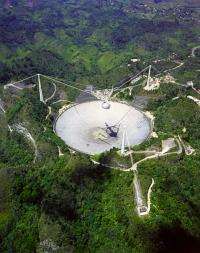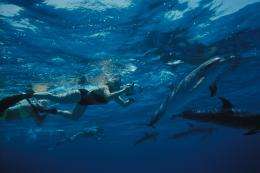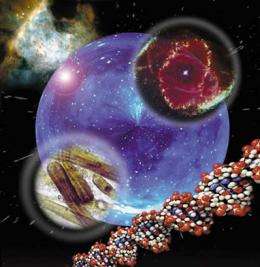Dolphins, aliens, and the search for intelligent life

How do we define intelligence? SETI, the Search for Extraterrestrial Intelligence, clearly equates intelligence with technology (or, more precisely, the building of radio or laser beacons). Some, such as the science fiction writer Isaac Asimov, suggested that intelligence wasn’t just the acquisition of technology, but the ability to develop and improve it, integrating it into our society.
By that definition, a dolphin, lacking limbs to create and manipulate complex tools, cannot possibly be described as intelligent. It’s easy to see why such definitions prove popular; we are clearly the smartest creatures on the planet, and the only species with technology. It may be human hubris, or some kind of anthropocentric bias that we find difficult to escape from, but our adherence to this definition narrows the phase space in which we’re willing to search for intelligent life.
Technology is certainly linked to intelligence – you need to be smart to build a computer or an aircraft or a radio telescope – but technology does not define intelligence. It is just a manifestation of it, perhaps one of many.
Astrobiologists see intelligence a little differently. The dictionary defines intelligence as the ability to learn, while others see it as the capacity to reason, to empathize, to solve problems and consider complex ideas, and to interact socially.
If we take these characteristics to be a broad working definition of intelligence, our view of intelligent life in the Universe suddenly looks very different. No longer are we confined to considering only life that has technology. To be fair to SETI, at this moment in time it cannot search for anything other than beacons – the vast distances across the cosmos coupled with our own baby steps into the Universe mean that we don’t have the capability to search for any other form of intelligent life other than those that can deliberately signal their presence. However, what a wider definition of intelligence tells us is that we are not alone, not even on our own planet Earth.
Professor Robin Dunbar, an anthropologist and evolutionary psychologist from the University of Oxford, was one of the first to put forward the theory that the evolution of intelligence is driven by social factors, allowing animals to survive, interact and prosper in large and complex social groupings. These include notions of reciprocal altruism (I scratch your back, you scratch mine), politics (forming sub-groups and coalitions within the larger group) and understanding the emotions of others (empathy, which in turn relies on theory of mind, the ability to be aware of one’s self and others). Looking at it that way, modern social networking on media such as Facebook may just be a symptom of what helped drive us to become intelligent in the first place, many tens of thousands of years ago.
Here’s the trick – to be social, you must be communicative. Staying quiet is anti-social. Personal interactions require communication, of some form, and the more complex the interaction, the more complex the communication. So if intelligence and social behavior is linked – and many people agree that it is – then the best place to start looking for intelligence is in animals that like to chat with one another. And that brings us to dolphins.
Ever since the 1960s, when John Lilly popularized the notion that dolphins may be cleverer than your average animal, dolphin intelligence has courted controversy, tempted us with tantalizing but thin evidence, and remained elusive. We know they are able to communicate by a variety of means, from whistles and barks to echo location, and researchers working with captive dolphins have discovered that they understand syntax, i.e. the difference between a statement and a question, or past and future tense. As Carl Sagan once famously said, “It is of interest to note that while some dolphins are reported to have learned English – up to 50 words used in correct context – no human being has been reported to have learned dolphinese.”
“Carl Sagan was right!” says Lori Marino, a biopsychologist from Emory University in Atlanta, Georgia. “We still don’t understand the natural language system of dolphins and whales. We know a little bit more now, and there have been investigators working on this for decades, but we haven’t really cracked the code.”
In that case, how can we be sure they even have a language? Justin Gregg, a researcher at the Dolphin Communication Project in Connecticut, is skeptical. “Most scientists, especially cognitive scientists, don’t think that dolphins have what linguists would define as language,” he says. “They have referential signaling, which a lot of animals do – squirrels and chickens can actually do that, and monkeys – and they have names for each other. But you can’t then say they have a language because human words can do so much more.”

Nevertheless, some scientists continue to fight in the dolphins’ corner. Referential signaling involves tagging things with names, such as having a specific whistle to identify sharks, or fishing boats, or food. “That sounds like a good definition of language to me,” says Laurance Doyle, a scientist at the SETI Institute in California. “Put it this way: the first premise that I think everyone agrees on is that all animals communicate, so once you buy that the next question is, how complex is each communication system?”
It is this question that has prompted Doyle to reappraise what we define as intelligent complex communication, and what types of signals we should be looking for with SETI. He applies a statistical analysis technique called information theory to languages in order to determine their complexity. It turns out that, according to information theory, dolphin communication is highly complex with many similarities with human languages, even if we don’t understand the words they are saying to one another.
Information theory was developed in the 1940s by the mathematician and cryptologist Claude Shannon, mainly to be applied to the then-burgeoning technology of telecommunications. It operates on the knowledge that all information can be broken down into ‘bits’ of data that can be rearranged in myriad ways. George Zipf, a linguist at Harvard, realized that language is just the conveyance of information, and therefore could be broken down too.
Think of all the different sounds human beings make as they speak to each other, the different letters and pronunciations. Some, such as the letters ‘e’ and ‘t’ or words such as ‘and’ or ‘the’ will occur far more frequently than ‘q’ or ‘z’ or longer words such as ‘astrobiology’. Plot these on a graph, in order of the most frequently occurring letters or sounds, and the points form a slope with a –1 gradient. A toddler learning to speak will have a steeper slope – as they experiment with words they use fewer sounds but say them more often. At the most extreme a baby’s babble is completely random, and so any slope will be nearly level with all sounds occurring fairly evenly. It doesn’t matter which human language is put through the information theory test – be it English, Russian, Arabic or Mandarin – the same result follows.
What is remarkable is that putting dolphin whistles through the information theory blender renders exactly the same result: a –1 slope, with a steeper slope for younger dolphins still being taught how to communicate by their mothers, and a horizontal slope for baby dolphins babbling. This tells us that dolphins have structure to how they communicate.
Meanwhile, another feature of information theory, called Shannon entropy, can tell us how complex that communication is.
Doyle makes the analogy to marching soldiers. Imagine one hundred soldiers on parade, walking in all different directions across a field. Then they are called to attention, and form ten neat rows of ten. Prior to the call to attention, when they are marching randomly, they have maximum entropy, maximum disorder, maximum complexity. Once they are lined up structure is imposed on them; their entropy decreases as does their complexity when coupled with a corresponding increase in structure.
Language is the same. Write down one hundred words on one hundred pieces of paper and throw them into the air and they can be arranged in myriad ways. Impose rules on them, such as sentence structure, and your choices automatically narrow. It is a bit like playing hangman; you have a five-letter word where the first letter is ‘q’, so the rule structure of English necessitates that the second letter is ‘u’. From thereon there is a limited number of letters that can follow ‘qu’ and so you may have ‘que’ or ‘qui’ or ‘qua’ and you can predict that the word is ‘quest’ or ‘quick’ or ‘quack’. Shannon entropy is defined as this application of order over data and the resulting predictability of that order.
“It turns out that humans go up to about ninth order Shannon entropy,” says Doyle. “What that means is, if you are missing more than nine words then there is no longer a conditional relationship between them – they become random and pretty much any word will do.” In other words, there are conditional probabilities, imposed by the rule structures of human languages, up to nine words away.
Doyle has analyzed many forms of communication with information theory, from the chemical signals of plants to the rapid-fire radio transmissions of air traffic control. How do dolphins fare? “They have a conditional probability between signals that goes up to fourth order and probably higher, although we need more data,” says Doyle.
The problem with studying dolphin communication is being able to study them for any great length of time out in the wild, which requires patience and money. This is where Denise Herzing comes in. She is based at the Wild Dolphin Project in Florida, and has spent much of her time working with the same pod of wild dolphins for the past 27 years, documenting the complexity of their communication, acoustic signals and behavior over that time period.

“We know them individually, we know their personalities, we know their communication signals and we already do things together that seem to be of interest [to them],” she says. “What we’re now trying to do is develop an interface that takes advantage of those small windows where we have their attention and they want to interact with us.”
This interface, developed with the assistance of artificial intelligence specialist Thad Starner at the Georgia Institute of Technology, and marine cognitive scientists Adam Pack of the University of Hawaii and Fabienne Delfour at the University of Paris, is known as CHAT, the Cetacean Hearing and Telemetry device. It’s a smart phone-sized gizmo that can I.D a dolphin whistle in real time. It’s worn around the neck of a diver and connected up to a pair of hydrophones and a one-handed keyboard called a ‘twiddler’. By agreeing with the dolphins on a common artificial language, neatly side-stepping the problem of translation, it is hoped that CHAT will enable humans and dolphins to talk in real time. For instance, dolphins will be able to request toys such as a ball or a hoop from humans, and vice versa. Although it won’t be the most meaningful conversation in the world, it will be conversation and that in itself will be revolutionary.
Still at the prototype stage, Herzing sees CHAT as an extension of all the work done in communication studies with captive dolphins over the past few decades. “To have high-powered, real-time computer technology to help us recognize specific signals that the animals make could empower us to bridge that gap and allow humans into their acoustic world,” she says. The plan is to test the device this year, before getting it out into the wild in 2012.
How complex dolphin communication really is remains to be seen. We must be careful not to anthropomorphize. We know their communication has nuances that are incredibly complex, but so do other species of animal, from bees to plants. Do dolphins have language with the scope and breadth to converse about anything like we can with human language, or is it more basic? Justin Gregg would argue the latter case.
“Essentially they do behave in complex and interesting ways, but there are no great mysteries in what they do that can only be answered with language,” he says.
Herzing and Doyle are more optimistic. “Dolphins have exquisite sound and they have a lot of places they could potentially encode information – we just haven’t looked adequately yet,” says Herzing. She has worked with Lori Marino and the SETI Institute’s Douglas Vakoch on how we can recognize intelligence other than human intelligence.
Meanwhile, Doyle has suggested that SETI should search for signals with information content that has a –1 slope. We may find that an alien signal displays complexity up to ten, fifteen, of twentieth order Shannon entropy. What would such a language be like?
To explain, Doyle highlights the example of Koko, a captive gorilla that has learned sign language and can understand concepts like “tomorrow” or “yesterday”. But combine time tenses, and Koko doesn’t understand.
“If you say to her, ‘by this time tomorrow I’ll have finished eating’, Koko doesn’t understand the two time jumps, that at some point in the future there will be a point in the past,” says Doyle. “Now imagine an alien comes with more complex abilities. They may say, ‘I will have to be have been there’. Now there’s nothing wrong with that per se, but humans can’t handle three time jumps or more. An alien could just think in a more complex way.” So instead of double entendres, they might have triple or quadruple entendres.
What all this tells us is that intelligence is manifest in communication just as much as it is in technology and, if intelligence is truly derived from social behavior, then it may be far more prevalent than technology. If intelligence is defined as the ability to learn, then intelligence brings with it culture, which means something that is learned. We see baby dolphins learning from their mothers so, in the crudest sense, we might say that dolphins have culture and intelligence.
By escaping the assumption that intelligence must equal technology, we see that there are many other intelligences on Earth – ask Lori Marino, and she’ll tell you that even the simplest multi-cellular life could be considered intelligent to a degree, thanks to its nervous system.
But it also poses a problem for SETI – if the Universe is full of intelligent, social, communicative but non-technological dolphins and the like, then there will be no radio beacons to transmit signals. The Universe could be full of life, of intelligence, and we would never know it.
Source: Astrobio.net



















